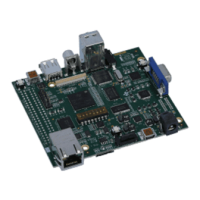USB Controller
other is DISABLE_NAK_LIMIT which indicates that there should be no limit on the number of
NAKs.
The USB_EP_DMA_MODE_ flags enables the type of DMA used to access the endpoint’s
data FIFOs. The choice of the DMA mode depends on how the DMA controller is configured
and how it is being used. See the “Using USB with the uDMA Controller” section for more
information on DMA configuration.
When configuring the OUT portion of an endpoint, the USB_EP_AUTO_SET bit is specified
to cause the transmission of data on the USB bus to start as soon as the number of bytes
specified by ui32MaxPayload have been written into the OUT FIFO for this endpoint.
When configuring the IN portion of an endpoint, the USB_EP_AUTO_REQUEST bit can be
specified to trigger the request for more data once the FIFO has been drained enough to
fit ui32MaxPayload bytes. The USB_EP_AUTO_CLEAR bit can be used to clear the data
packet ready flag automatically once the data has been read from the FIFO. If this is not
used, this flag must be manually cleared via a call to ROM_USBDevEndpointStatusClear() or
ROM_USBHostEndpointStatusClear().
Note:
This function should only be called in host mode.
Returns:
None.
24.3.1.30 ROM_USBHostEndpointDataAck
Acknowledge that data was read from the given endpoint’s FIFO in host mode.
Prototype:
void
ROM_USBHostEndpointDataAck(uint32_t ui32Base,
uint32_t ui32Endpoint)
ROM Location:
ROM_APITABLE is an array of pointers located at 0x0100.0010.
ROM_USBTABLE is an array of pointers located at ROM_APITABLE[16].
ROM_USBHostEndpointDataAck is a function pointer located at ROM_USBTABLE[23].
Parameters:
ui32Base specifies the USB module base address.
ui32Endpoint is the endpoint to access.
Description:
This function acknowledges that the data was read from the endpoint’s FIFO. This call is used
if processing is required between reading the data and acknowledging that the data has been
read.
Note:
This function should only be called in host mode.
Returns:
None.
April 8, 2013 323

